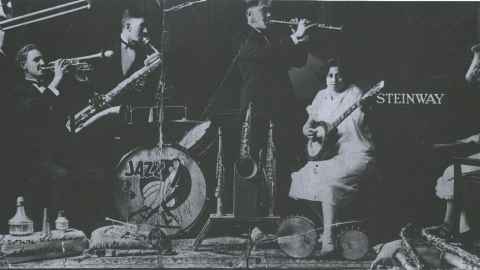All that (New Zealand) jazz
4 June 2025
Far from being removed from the world's great music hubs, New Zealand had a vibrant early jazz scene, explains music historian Dr Aleisha Ward.

“Long before there was sex, drugs and rock ’n roll,” says Dr Aleisha Ward, “there was sex, drugs and jazz.”
Aleisha, a music historian from the School of Music, says jazz started spreading around the world, including to New Zealand, in 1917, as World War One servicemen sought respite from the horrors of war by going out to “dance, drink and have some fun”.
They poured into London, Cairo and particularly Paris, for rest and rehabilitation, where they heard popular American band leaders like James Reese Europe and his Harlem Hellfighters – one of the earliest bands whose style moved from ragtime to what would become jazz.
Aleisha is currently writing a history of ‘the long jazz age’ (1917–1935) in New Zealand.
“Jazz wasn’t a specific genre,” she says. “I like to say it was a verb and an adjective. You could jazz anything up using improvisation, swing rhythm, and jazz effects, like talking mute sounds, to make any music jazz.
“Jazz was also dance and comedy. Before jazz became known for the virtuoso improvisations of artists like Louis Armstrong, jazz was the popular social dance music of its time, and it influenced other things like fashion and nightlife.”
Jazz came to New Zealand via sheet music, radio (from 1921) and the gramophone recordings that became the new “tech toy” of the middle classes.
Jazz wasn’t a specific genre. I like to say it was a verb and an adjective.
And New Zealand, despite being far from music hubs in the US and Europe, had a vibrant entertainment scene in the 1920s and 30s. This was despite strict drinking laws, which were routinely flouted by clever tricks such as female patrons hiding wine bottles under their dresses in special garter belts, says Aleisha.
“Our tabloid The New Zealand Truth [1905–2013] had so many articles about young people, particularly young women, ‘taken off the right path’ by jazz; falling into drugs and alcohol and pre-marital sex … all because of jazz.”
Global vaudeville circuits also revived after World War One, she says.
“The most famous was The Red Line, a circuit that started in Britain, went across Europe, the Middle East and Asia, then to Australia and New Zealand on a three or four-year tour, and performed in our main cities.”
While the acts often brought their own musicians, in some cases they used the venue’s musicians – some of whom became the first jazz artists in the country. These included percussionist Bob Adams, says Aleisha, the founder of the first local jazz band.
A New Zealand jazz pioneer was band leader Walter Smith (Ngāti Kahungunu), who moved to Utah around 1890 where he studied music. He later performed ‘Hawaiian’ music on the US vaudeville circuit. On his return to New Zealand, he became an influential teacher and performer, advocating for jazz as a modern expression of music.
About a third of jazz musicians and leaders in the 1920s were women, adds Aleisha. “There was a Miss MacDonald in Christchurch who led several types of ensembles and was also an accompanist to singers on the recital stage.”
These early artists, she says, are the forerunners of great New Zealand jazz acts like Quincy Conserve, The Rodger Fox Big Band, Dr Tree, Nathan, Kevin and Joel Haines, Mark de Clive-Lowe and Phil Broadhurst.
Julianne Evans
Hear Aleisha Ward discuss the history of jazz in Aotearoa on the Faculty of Arts and Education’s Research and Reason podcast.
This article first appeared in the June 2025 issue of UniNews.